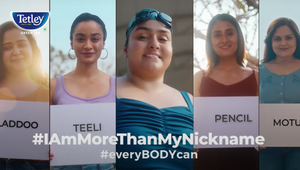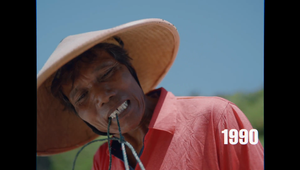
5 Minutes with… Amar Singh

Lowe Lintas’ Amar Singh has been in the industry pretty much since he finished his education – though his first interaction with that power of communicating to a mass audience began during his college days when he was tasked with designing and writing copy for a festival. Shortly after he joined Lowe Lintas where he worked himself up to the position of regional creative officer after almost 18 years with the agency.
During his career Amar has seen the industry and India’s communications sector pivot with the rise of technology and a new way of meeting consumer demands. Though, nothing at all could prepare the industry for the impact of Covid-19 and while he believes it's too soon to focus on a ‘new normal’, the innovative and collaborative ways he and his team have been working have shown the power of creativity like nothing before.
To hear more about Amar’s experiences and where he believes creativity in India is heading, LBB’s Natasha Patel caught up with him to find out more.
LBB> Tell us about your childhood - where did you grow up and was creativity a big part of it?
Amar> I grew up in Dehradun and Ajmer. Both towns are known for their residential public schools. Two of which I consider home, since my mum spent a large part of her career as an educationist there. Having lots of friends around me during term and having fewer friends but all the grounds to play in during the holidays made growing up in both places very interesting and a tremendous amount of fun.
All manner of creative pursuits from music to theatre to creative writing were always encouraged in both schools and at home where I would pretty much read any book I could lay my hands on. From Bertrand Russell who sat in my grandfather’s bookshelf to Batman who sat in mine.
LBB> I know that you studied economics at university and you're a fan of creative writing but when did you decide that advertising was the path for you?
Amar> In a manner of speaking, I got into advertising in my first year of college, when I found myself pulled into the publicity department of our annual festival at the last minute. Churning out posters by the dozen, doodling on chart paper and writing one foolish line after another simply because they made my friends laugh, seemed just the sort of thing to make a career in. Still does. Formally, I began writing for Lowe towards the end of 2003.
LBB> You've been at Lowe for close to 17 years which means you must have seen a lot of changes both in creativity and in audiences. What have been the biggest ones to you?
Amar> Several changes can be chalked up to evolution and obsolescence and that’s only to be expected. But over this time, I think brands have begun respecting the consumer more and consumers have started revering brands a little less. Which has brought both closer to an equal footing than they’ve ever been before. And this has made for far more interesting conversations and far more relatable communication between them.
This levelling can also be seen in other creative fields where fan fiction sometimes reads better than original text, music made in a small personal studio at home can get more views and downloads than songs from big labels and movies and TikTok videos made on a phone can rival scenes from big budget productions. It’s truly an exciting time to create and absorb creative work.
LBB> How would you categorise India's creative scene and how do you keep ahead of consumer trends?
Amar> I think it’s more vibrant than ever because creativity is now not just within the purview of the few. The power to create is quite literally in everyone’s hand. And personally, I don’t feel it’s about keeping ahead of trends. I think it’s more about just observing, absorbing and most importantly experiencing life. No amount of trend gazing can substitute the experience of it.
LBB> Tell us about Flipkart’s Choose Your Age campaign - where did the idea come from and how did you bring the vision to life?
Amar> Ageism was something the brand wanted to take on as part of a campaign for brand love. And this was an idea just waiting to be discovered. It’s something that’s particularly dear to me because it respects all of us as individuals and it connects with us in the way we would like to see ourselves. Not in the way others might be seeing us. Freeing yourself of the perceptions of others, especially regarding something that is beyond anyone’s control like your age. Is very liberating.
The fact that you can choose to define your age not in terms of the number of years you’ve spent on this earth, but in terms of the number of mountains you’ve climbed, the number of holidays you’ve taken, the number of concerts you’ve been to. I think it connected with everyone involved with it, from the brand team to the production team, at a visceral level. And everyone involved with it, gave it their all. Hopefully it’ll connect with everyone who watches it, even today.
LBB> I know you work on a lot of Axis campaigns which centre around the ‘Dil Se Open’ [open from the heart] thought - how do you ensure that each brief goes back to this view?
Amar> We attempt to do this by paying attention to the intent of the brief along with the specifics of the product or service that needs to be promoted. Because the connection that ties any piece of communication back to the bank’s open philosophy is more than just the inclusion of the word open. It includes what the bank does to open a world of opportunities for its customers. It includes the wholeheartedly open manner in which the bank does this. And sometimes it also includes instances when the bank asks its customers to keep their minds or their hearts or their points of view open to wonderful possibilities.
Each piece of communication also has a simplicity in its tone and manner which connects back to the brand without straight jacketing the creative.
LBB> As a creative place, India is full of so many different trends, cultural nuances and constant change, how do you think all of this will translate into the future?
Amar> I think it’ll simply keep leading creators to get inspired by those different trends, cultural nuances and constant change. Advertising, very much like its first cousin art, will always reflect life. And vice versa. And this isn’t a phenomenon specific to India. Because of our sheer size and diversity, it’s perhaps just more noticeable here.
LBB> Tell us about Mumbai as a creative hub.
Amar> Mumbai’s always had tremendous creative energy. For all manner of creativity, commercial or otherwise. And I don’t think that’ll ever change. A lot of the best creative infrastructure, studios and technicians continue to reside here. But the spread of internet across the length and breadth of our country and to a large extent how things have been in the last year, have made people delink geography from creative work. It really doesn’t matter where you are now. Ideas flow, minds meld and stuff comes together just as it would have if everyone was in the same space in Mumbai. And I see this as a good thing. The possibilities now are practically endless.
LBB> Covid-19 has - and still is - changing India so much. What have seen the biggest changes when it comes to creating campaigns due to the pandemic?
Amar> I think the enormity of what we are experiencing escaped a lot of us. Marketing and advertising in particular became obsessed with defining and redefining the ‘new normal’. An utterly absurd phrase which doesn’t even make sense until things have reached some semblance of having settled down. This eagerness naturally resulted in some degree of tone deafness. But overall I think the brands which chose to advertise with the intent of helping people or the brands which advertised without contextualising the pandemic found themselves in a better place than those that saw this as a brand building opportunity.
On the other side, both in terms of collaborating across distances and adaptive film making, this period was an absolute revelation. From shooting on phones, to attending shoots on phone to sending sanitised cameras to the cast’s house, to edits via screen-grabs. Getting creative about how we get creative has been quite a ride. And also an affirmation for those of us who always believed our work wasn’t bound by our location.
LBB> How much of your time is spent on digital campaigns?
Amar> A fair bit and not nearly enough. Over the last few years, my teams have done some showcase digital work in the automobile, finance and food spaces. But as one of the oldest advertising agencies, it isn’t enough for us to just have the minds and the ideas. We also have to battle perception. Sometimes it isn’t enough to do practically everything online, it’s important to also be thought of as a ‘digital native’. But perceptions are temporary. At the end of the day, it’s always the quality of the idea that counts. And that’s something that will always be at the heart of what we do.
LBB> With that in mind, do you still believe that India has a scope for print campaigns too?
Amar> If you mean campaigns specifically designed for newsprint, then I’m afraid the readership numbers might just continue to dip and finally plateau for the foreseeable future. And that would of course affect media plans. But that’s only for newsprint as a medium. The same content, by the same publication, licensed and placed behind a paywall, will continue to attract readership. And that will continue to attract advertising campaigns.
If however, you are referring to the conventional core nature of print campaigns as being relevant, topical, short term announcements, those will always undoubtedly continue to exist and even thrive whether onsite or online.
LBB> Any parting thoughts?
Amar> The present situation, unfortunately for us, will probably get worse before it gets better. But one day, it will get better. And with that in mind, a while ago I came across this meme with a spin on a famous line from Rick and Morty.
A disgusted Rick tells Morty – “You just experienced a world event that brought your way of life to a complete standstill. And then you went back to the way things were?? Boo!”
And to everyone reading this, please stay safe. Don’t let your guard down. You are essential for the ones who love you.













